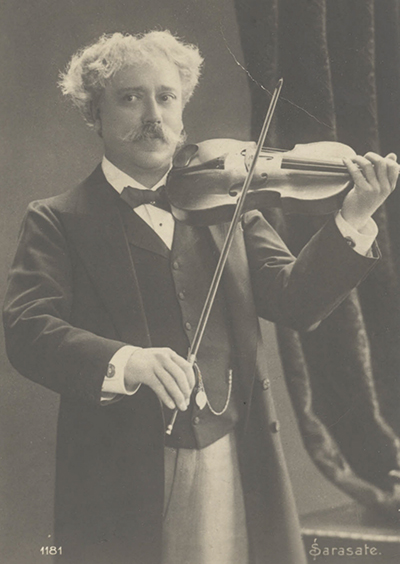Pablo Sarasate

Born: March 10, 1844, Pamplona, Spain
Died: September 20, 1908, Biarritz, France
Carmen Fantasy
- Composed: 1881
- Premiere: April 17, 1881 in Madrid, conducted by Mariano Vásquez with composer as soloist.
- Duration: approx. 12 minutes
Pablo Martín Melitón de Sarasate y Navascuez — economized to Pablo de Sarasate when he became a star — occupied, with Niccolò Paganini and Joseph Joachim, the pinnacle of 19th-century fiddledom. The son of a military bandmaster in Pamplona, Spain, he started violin lessons at five, gave his first public performance at eight, and rocketed past the pedagogical prowess of the best local teachers so quickly thereafter that he had to be sent to the Paris Conservatoire for further instruction with Delphin Alard at the age of twelve. So much promise for furthering the cause of Spanish culture did he show that Queen Isabella presented him with a Stradivarius violin (a handsome piece of booty acquired in a recent tiff with Naples), and personally authorized the subsidy of his expenses. Within a year, he won a premier prix in violin and solfège at the Conservatoire, acquired another prize, in harmony, in 1859, and then set off on the tours of Europe, Africa, North and South America and Asia that made him one of the foremost musicians of his time. (His first tour of the United States was in 1870; his last in 1889.) His playing drew unstinting praise during the 40 years of almost constant, world-wide concertizing that followed, the most impressive evidence of which is the spectacular list of works that were written for him by some of the era’s greatest composers: Bruch’s G Minor Violin Concerto and Scottish Fantasy; Saint-Saëns’ Concertos Nos. 1 and 3 and the Introduction and Rondo Capriccioso; Lalo’s Concerto in F Minor and Symphonie espagnole; Joachim’s Variations for Violin and Orchestra; Wieniawski’s Second Concerto; Dvořák’s Mazurek; and Mackenzie’s Pibroch Suite. Whereas Paganini was noted for his flamboyant technical wizardry and emotional exuberance, and Joachim for his high-minded intellectualism and deep musical insights, Sarasate was famed for his elegance, precision, apparent ease of execution and, in the words of Eduard Hanslick, the Vienna-based doyen of Europe’s music critics, his “stream of beautiful sound.” No less an authority than the great violinist Eugene Ysaÿe said, “It was he who taught us to play exactly.” Sarasate was also a keen chamber music participant, and he was among the early champions of Brahms’ quartets, though he declined to play that master’s Violin Concerto. The handful of recordings he made shortly before his death in Biarritz in 1908, the first commercial discs made by a world-famous violinist, attest to his remarkable skill.
Sarasate augmented his performance repertory with more than fifty compositions of his own creation, all of them in a lighter vein and many reminiscent of folk models. Among his compositional specialities was a species of virtuoso fantasy based on themes from popular operas of the day — Der Freischütz, Don Giovanni, Faust, La forza del destino, Martha, Mireille, Roméo et Juliette, Zampa — that he prepared for his concert appearances with orchestra. The only one of this clutch of violin showpieces that remains in the repertory is the scintillating treatment of several numbers from Bizet’s Carmen which he devised for a Paris concert in 1883. The Carmen Fantasy (dedicated to Joseph Hellmesberger, a distinguished violinist remembered as an advocate of Brahms’ chamber music and as director of the Vienna Conservatory) borrows some of the best-loved melodies from Bizet’s timeless masterpiece: the Entr’acte between Acts III and IV; Carmen’s Habanera; the scene of Carmen, Don José and Zuniga, “Mon officier c’était une querelle”; the Séguidille from Act I; and the Chanson Bohème from Act II.